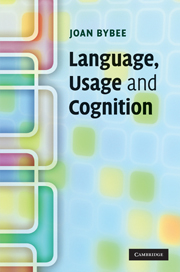Book contents
- Frontmatter
- Contents
- List of figures
- List of tables
- Acknowledgements
- 1 A usage-based perspective on language
- 2 Rich memory for language: exemplar representation
- 3 Chunking and degrees of autonomy
- 4 Analogy and similarity
- 5 Categorization and the distribution of constructions in corpora
- 6 Where do constructions come from? Synchrony and diachrony in a usage-based theory
- 7 Reanalysis or the gradual creation of new categories? The English Auxiliary
- 8 Gradient constituency and gradual reanalysis
- 9 Conventionalization and the local vs. the general: Modern English can
- 10 Exemplars and grammatical meaning: the specific and the general
- 11 Language as a complex adaptive system: the interaction of cognition, culture and use
- Notes
- Bibliography
- Index
5 - Categorization and the distribution of constructions in corpora
Published online by Cambridge University Press: 05 June 2012
- Frontmatter
- Contents
- List of figures
- List of tables
- Acknowledgements
- 1 A usage-based perspective on language
- 2 Rich memory for language: exemplar representation
- 3 Chunking and degrees of autonomy
- 4 Analogy and similarity
- 5 Categorization and the distribution of constructions in corpora
- 6 Where do constructions come from? Synchrony and diachrony in a usage-based theory
- 7 Reanalysis or the gradual creation of new categories? The English Auxiliary
- 8 Gradient constituency and gradual reanalysis
- 9 Conventionalization and the local vs. the general: Modern English can
- 10 Exemplars and grammatical meaning: the specific and the general
- 11 Language as a complex adaptive system: the interaction of cognition, culture and use
- Notes
- Bibliography
- Index
Summary
Introduction
In the preceding three chapters we have considered some of the basic processing mechanisms that give language its structure. First we considered memory representations for language, arguing for the necessity of exemplar or rich memory representations. Then we considered sequential chunking and its importance for morphosyntactic structure. In this discussion we also saw how chunking interacts with analysability and compositionality and their loss as autonomy increases. In Chapter 4, categorization and similarity were approached in the discussion of analogy as a mechanism for extending the use of constructions with novel items. The current chapter looks at constructions in more detail, considering in particular the distribution of particular tokens and types of constructions in language use. The focus is on the nature of the categories that are created for the open slots in constructions and how both type and token frequency interact with semantic categorization to determine the properties of these categories, their degrees of schematicity and their productivity.
Why constructions?
Constructions are direct pairings of form with meaning (where meaning also includes pragmatics), often having schematic positions that range over a number of lexical items. Constructions often contain explicit lexical material, such as way or what and be doing as in the examples in (1). While everyone who works on constructions agrees that they cover everything from mono-morphemic words, to complex words, to idioms, all the way up to very general configurations such as ‘the passive construction’ (because they are all form–meaning pairings), the term is usually applied to a morphosyntactically complex structure that is partially schematic.
- Type
- Chapter
- Information
- Language, Usage and Cognition , pp. 76 - 104Publisher: Cambridge University PressPrint publication year: 2010



